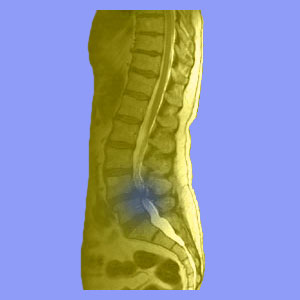
Cauda equina syndrome is often the result of acute back trauma which causes injury to the lower end of the central spinal nerve structures. CES may also occur due to extreme degenerative changes in the lumbar and lumbosacral spinal areas, as well. The bottom of the spinal cord is situated in the upper lumbar area. At the end of the spinal cord, the cauda equina branches off, continuing to traverse the central canal until each nerve root exits through its proper neuroforaminal opening.
The cauda equina, or horse’s tail, is a structure comprised of several large neurological tissues which extend to form the spinal nerve roots in the lumbar, sacral and coccygeal spinal regions. In essence, it replaces the spinal cord within the central canal in the mid lumbar levels and below.
Cauda Equina Syndrome Defined
CES is a serious condition that occurs when some structure compresses one or more of these spinal nerves in the lower back. In most instances, multiple roots are affected, enacting widespread symptoms, including sciatica.
Typical signs are extreme pain and weakness in the lower body and the inability to control bowel and/or bladder functions. The patient may not be able to stand and might even be partially paralyzed in the legs. Sexual dysfunction is commonplace.
CES is a medical emergency, since damage to the spinal nerves can become permanent and should be treated immediately. CES should not be confused with typical nerve compression, which might be painful, but is not usually a major health threat.
CES Causes and Treatment
CES can be caused by many possible sources:
Severe lower back trauma can cause CES. This is commonly seen in car accident victims and those who suffer other significant lumbar injuries.
Herniated discs can cause CES in rare instances, particularly in combination with other factors which narrow the canal space.
Extreme spondylolisthesis might cause CES if the spinal nerves become compressed in a misaligned central canal in grade 3 or 4 circumstances.
Any form of extreme spinal stenosis might cause CES. Arthritis is the usual culprit, but disc pathologies and ligament hypertrophy can also contribute.
Single or multiple vertebral fractures can cause CES in rare instances.
Treatment depends greatly on the causation and severity of symptoms. The worst cases are typically surgical emergencies and necessary measures will be taken to correct nerve compression in the operating room.
Less severe instances of CES might be observed and managed more conservatively, hoping for symptomatic resolution without surgery.
A good general rule states that injurious instigators will almost always involve emergency surgical intervention, while degenerative conditions may or may not.
Cauda Equina Syndrome Warnings
CES is a real nightmare, but is luckily a rare event, even with significant back injury. Diagnosis of any condition which even vaguely resembles CES should be made immediately by a qualified emergency unit or trauma center. Do not play around with such severe spinal symptoms, as they might lead to permanent disability or functional reduction. Be warned also, that some lower back conditions might appear to be much like CES, but do not have the same problematic potential. Some lumbar issues might enact scary symptoms, including urinary concerns, but might resolve quickly and without treatment.
Psychosomatic sciatica symptoms can also include completely harmless urinary and bowel problems, but can only usually be effectively treated with knowledge therapy.
Cervical spinal stenosis is one of the worst offenders, since it can basically mimic cauda equina pain syndrome in its severe forms and will enact identical expressions from direct compression of the spinal cord in the neck. Remember, accurate diagnosis of CES is the most important part of recovery. If the true causation can be ascertained, then the prognosis for resolution is generally good.





